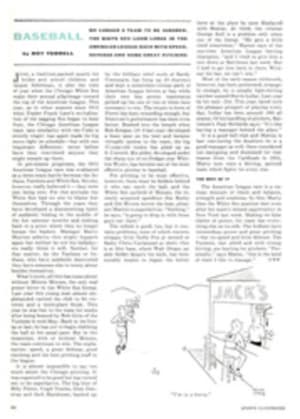
THE AMALFI DRIVE
The Monti Lattariis a bumpy peninsula that somewhere south of Pompeii takes a sudden turn forthe Tyrrhenian Sea. It does so with great impulsiveness, so that cliffs andmountainsides drop off abruptly into the blue. A spittle of land that seems tohave spilled offshore in the rush has become the isle of Capri.
But tucked away inthe wedges and the creases of the Monti Lattari, hiding from the urbanity ofNaples across the gulf, safe from the sloping boil of Vesuvius not an houraway, insulated by the geography, the communications and the incredible roadsfrom the telephone, the telegraph and the tripper, are four of the world's mostromantic retreats—Sorrento, Positano, Amalfi and Ravello. Here in the sphere ofNeapolitan influence, baking pizzas flare the noonday nostril; the breeze istoasted as it floats over from the hot Sicilian acres, and Neapolitan tenorstwang the love strings of their guitars as they moon away the wine-filled,oleander-scented nights. This entrancing combination coaxed Goethe, Byron andOscar Wilde to Sorrento; Longfellow to Amalfi; Richard Wagner and Garbo andStokowski to the heights of Ravello.
The list ofromanticists who flock to Positano grows longer by the day, for Positano is thecurrent darling of the corkscrew strip known as the Amalfi Riviera. Maugham hascalled it "almost excessively picturesque." Steinbeck termed it "adream place that isn't quite real when you are there and becomes beckoninglyreal after you've gone." It is an old and sun-bleached village jammed intoa crevice between two mountains. Its only vehicle road is the Amalfi Drive thathairpins along the south wall of the Monti Lattari on its way to Salerno.
Running from themountain-top villas down the steep incline to the sea is a pathway of hundredsof steps that echo daily with the wooden zuccoli on the feet of the women. Saida breathless American visitor last summer, "Positano is nothing but a44-story building with outside staircases." And a Pan-American publicrelations man, normally based in Paris and fattened by the Laperouse-Tourd'Argent circuit, has written me from Positano, where I had directed him,complaining that "it is a bit too vertical for men of our years."
But besides all itsnatural charms, which made it a popular art colony for German painters longbefore the war, Positano's present notoriety can be charged in some measure to"Scalinatella," a hit song sung the length of Italy by Roberto Murolo,a Neapolitan tenor. It is the story of a lover who climbs the 396 stairs ofPositano to look for his amour, who, it turns out, is forever dallying at Caprior someplace with some foreign type while he becomes a lovesick cardiac.
In the morning thearty foreign coterie trundles out of the pension Casa Maresca ($5 a day withmeals), from elegant little hotels like the Miramare and the Syrenuse ($8 aday) owned by the mayor, and joggles down the scalinatella to the pebbly beach.Here a beachmaster in a red straw hat, armless undershirt and rolled-upbleached denims will take out his notebook and with a stubby pencil jot downthe hour you wish to be returned to the beach.
Then he will sendyou out by skiff to the offshore rock of your choice. There you turn and toastand swim until the boat chugs back to collect you.
The afternoons areto shop in, for mortised in between the jumble of houses on the sloping roadsare a dozen ateliers where artisans can weave you a sweater, sew you a beachjacket, or whip up a made-to-measure shirt in a day or two. The fashions are ondisplay nightly in a waterside den known as the Buca di Bacco where the coterieeats and dances, then scales a rockside walk, mushes off across another pebblebeach and tumbles finally into For-nillo. Here a dance band plays sleepy musicuntil quitting time after which a Neapolitan tenor who performs over theItalian TV under the name of Rino da Positano strums and sings the sad songs.And at last the crowd sings out its own entertainment while climbing the rockywalk back to the pensions, the hotels, the villas and the furnished rooms amongthe crags. Then the town is dark and the only lights are the lampare of thefishing boats that lure the squid and octopus from the sea with white acetylenebeams.
Things are a gooddeal more peaceful down the bent-hairpin highway at Amalfi which, likePositano, rises up a steep hillside from the narrow pebble beach which was onceits doorway to the world. A seagoing republic of 70,000 citizens in its saladdays back in the 10th and 11th centuries, Amalfi wrote and practiced the firstmaritime laws, helped perfect the compass, originated the first maritimeinsurance.
Amalfi goes to seano more, except to bathe. Today it is a resort, a dowager town, a favorite ofthe big burghers who come down from Switzerland and Germany and delight in itsrock-bound hotels. To get up to the Cappuccini, you take an elevator from themain road that lifts you up among the steppes. In the 12th century this loftyhideaway was a sanctuary of the Capuchin monks, and although it is a hotel ofpremier order today, it has retained the basement chapel where services arestill held every Sunday. Some of its monks' cells, in the new order, havebecome hotel rooms.
When the AmalfiRepublic was trading oranges in the ports of the Near East, the wealthy nobles,the shipping magnates of the 10th century, established a smart faubourg calledRavello. Four miles up behind Amalfi, it is perched, almost precariously, on alimestone spur 1,100 feet above the sea. Ravello's square is a small delight,but the Villa Rufolo, with its garden walks, its brilliant flower beds, itsfountains and its palms, the perfume of its orange blossoms, its view of thehills around and the shining sea below is as close to fantasy as reality evergets.
Boccaccio took inthe sight and wove a tale about it. Wagner saw it and exclaimed, "Theenchanted garden of Klingsor (in Parsifal) has been found." Of all theworld Garbo and Stokowski chose it for their startling liaison in 1939. Legendsof romance can do wonders with real estate values, but Ravello proved theexception. It is too far from the sea and the famed romance was badly timed.Signor Caruso, who owns the leading Caruso-Belvedere Hotel, an inn more valuedfor the art collection on its walls than its daily receipts, sits by the archedwindows looking out at the fabulous view and shakes his head sadly. "Ah, ifStokowski and Garbo had come any other time but 1939," he says, "theworld would have remembered." But '39 was a bad year for romance and thewar crowded it off the headlines and deadened the memory.
The hardy perennialof the Monti Lattari is Sorrento which turns its back to the Amalfi Drive, andlooks instead to Naples across the Golfo di Napoli. There is scarcely apracticing Neapolitan tenor alive who has not opened his mouth more times tomoon about returning to Sorrento than to admit a fresh-baked, mozzarella-paved,tomato-colored, anchovy-seasoned Neapolitan pizza.
"Torna aSurriento," originally a prize winner in the annual Naples songfest, hasproven probably to be the most successful sales jingle in history. Royalty hashit this vacation spot in an unbroken string from the 1870's when the grandhotels were built up to the present day. What Sorrento produced in turn was agentle climate, magnificent flowers that are nurtured on soil brought from theNile Valley as ship ballast, oranges, a jerky dance called the Tarantella,boxes of bergamotti —¬†a small, bitter type of orange which producesaircraft lubricating oil and cologne — and, of course, uncounted choruses of"Torna a Surriento." Most of the hotels are perched at the very brinkof the cliff. At the bottom is the sea where the Capri boat stops by every day.If you live in the Vittoria, nee the Grand Hotel Excelsior Vittoria, you rideback and forth in an elevator. If you live anywhere else, it's just a short,exhausting walk from the beach.
PHOTO
THE DRIVE climbs from the Amalfi seaside to the 1,100-foot
aerie that is Ravello, completely reversing itself every 300 yards.
MAP
THE AMALFI DRIVE TWISTS FROM SORRENTO TO RAVELLO, ALONG THE TYRRHENIAN SEA
GLUF OF NAPLES
Ravello Amalfi
Positano
Sorrento
AMALFI DRIVE
CAPRI

